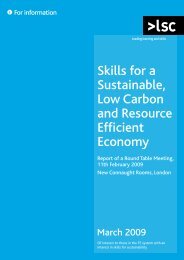Mapping the Big Green Challenge - The Skills & Learning ...
Mapping the Big Green Challenge - The Skills & Learning ...
Mapping the Big Green Challenge - The Skills & Learning ...
You also want an ePaper? Increase the reach of your titles
YUMPU automatically turns print PDFs into web optimized ePapers that Google loves.
48 Chapter 5 - Expected Innovation Goals<strong>The</strong> distinction between 'interlinked' changes where for example <strong>the</strong> technologies and practicesinvolved are relevant to a broader shared goal (an approach which is likely to be relatively significantin innovation terms) and a series of innovations which have no intrinsic connection is captured by<strong>the</strong> contrast between <strong>the</strong> 'systemic' and 'multiple' categories.Where ideas were considered systemic <strong>the</strong>y were fur<strong>the</strong>r divided into ones which were systemic ina ‘vertical’ sense (usually linking changes along a supply chain, often linking producers andconsumers) and, more commonly, those that were ‘horizontal’ (sharing a focus). In <strong>the</strong> latter case<strong>the</strong> level at which <strong>the</strong> systemic ideas were targeted – e.g. household, building / site, community.(Note: horizontal systemic are just labelled systemic on <strong>the</strong> charts). Chart 19 shows all proposalscategorised in this way. <strong>The</strong> nearly 60% of proposals categorised as systemic in some ways is apositive indication that <strong>Challenge</strong>rs were tending to approach climate change mitigation in arounded way which might be expected to have a greater impact than a singular focus. As discussedearlier, holistic action around, say, one’s home may well make more sense to people than separatemessages about turning <strong>the</strong> lights off, putting in insulation, recycling, etc.<strong>The</strong> proportion of vertical systemic innovations, while small, is of particular interest in relation to <strong>the</strong>creation of opportunities for niche innovations to be supported since <strong>the</strong>y create relationships whichmake it more likely <strong>the</strong> innovation will become established. Proposals with this characteristic areparticularly prominent in one proposal type and arediscussed at Section 7.9: Low CarbonConnections.Chart 20 shows <strong>the</strong> level at which <strong>the</strong>(horizontal) systemic proposal operated. <strong>The</strong>40% of proposals that had a communityfocus is notable. It means that <strong>the</strong>seproposals went beyond <strong>the</strong> household levelto include issues such as transport or landuse. This is likely to be distinctive from <strong>the</strong>approach of public campaigns by governmentwhich tend to focus on people in relation to<strong>the</strong>ir individual homes and purchases. <strong>The</strong>Building / Site category often refers toproposals which focused on some form ofpublic building. Some of <strong>the</strong>se had strong‘out-reach’ dimensions based on models ofSupply chain7%Chart 20 - Breakdown of systemicproposals, 195 proposalsMixed9%Community40%O<strong>the</strong>r2%Individual5%Household13%Building/Site14%Organisation10%community engagement and thus intended <strong>the</strong>ir proposal to lead to wider systemic changes. This isissue is picked up on in Section 7.6: Low Carbon Public Buildings.Appleby Ltd July 2009











